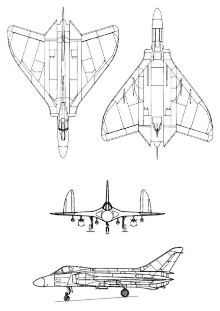Douglas F4D
| Douglas F4D / F-6 Skyray | |
|---|---|
 US Navy F4D-1 1960 (VF-102, USS Forrestal ) |
|
| Type: | Fighter plane |
| Design country: | |
| Manufacturer: | |
| First flight: |
January 23, 1951 |
| Commissioning: |
April 1956 |
| Production time: |
1956 to 1958 |
| Number of pieces: |
420 |
The Douglas F4D Skyray (German sky ray) was a carrier-based fighter aircraft built by the Douglas Aircraft Company in 1954.
description

Building on the German experience with delta wings , Douglas designed a carrier-supported interceptor with such a wing design in 1947. The design was approved on December 16, 1948 through a contract for the procurement of two XF4D-1 prototypes . The first flew on January 23, 1951 with an Allison J35-A-17 jet engine with 2,270kp thrust, but this was an emergency solution, as the completion of the originally planned Westinghouse J40 had been delayed. Later both prototypes received the XJ40-WE-6 (3,175 kp) and XJ40-WE-8 (5,265 kp with afterburner). Persistent problems with these engines ultimately led to the decision to convert the machines to the now proven Pratt & Whitney J57 .
The model went into series production as the F4D-1 " Skyray ". The Skyray was designed as a cantilever middle-decker with a delta wing and elevon controls. The delta wing had rounded wing tips, the air inlets of the engine were located in the wing roots. The machine had fuel tanks in the wings and in the fuselage. The rudder was swept, the pilot sat far in front of the wing and thus had a good all-round view. The Skyray was armed with four 20 mm cannons and up to 1500 kg external loads at six under wing stations, including two AIM-9 Sidewinder guided missiles.
Although the aircraft was only in service for a short time and was never used in combat, it showed great potential. On October 3, 1953, the second prototype set a world speed record for carrier-based aircraft at 1,211.746 km / h. As the first aircraft in the US Navy , it was able to hold Mach 1 in level flight .
The first series aircraft F4D-1 flew on June 5, 1954 with the J57-P-2 (6,125kp with afterburner), the delivery of the series machines was delayed until April 1956. Later the series machines received J57-P-8 engines, without changing the type designation of the aircraft.
As the first squadron in April 1956, the VC-3 was equipped with the F4D-1. It was later renamed VFAW-3 and was the only US Navy squadron to report to NORAD . VFAW-3 was stationed on Naval Air Station (NAS) North Island near San Diego . The following USN squadrons flew the F4D: VFAW-3, VF-13, VF-23, VF-51, VF-74, VF-101, VF-102, VF-141, VF-162, VF-213, VF- 881 and VF-882. The Skyray was also flown by the US Marine Corps , including squadrons VMF-113, VMF-114, VMF-115, VMF-215, VMF-314, VMF-513, VMF-531 and VMF-542. A total of 420 F4D-1s had been built until production was discontinued in December 1958. In September 1962 she was reclassified as F-6A as part of the change in the marine type scheme . At that time, only the VFAW-3, VMF-114, VMF-531 and VMF (AW) -542 squadrons and the reserve squadrons VMF-215, VF-881 and VF-882 flew the Skyray . As the last season, VMF (AW) -542 used the F4D-1 until February 1964, which was affectionately called Ford by its pilots .
The distinctive appearance made the F4D one of the most famous early jet aircraft . She had an excellent rate of climb with an enormous climb angle and set new world altitude records. The Skyray was developed as a high-altitude interceptor, but it was used as a multi-function fighter. One aircraft ( BuNo 134759) went to the National Advisory Committee for Aeronautics (NACA) and was used there until 1959.
The planned successor Douglas F5D Skylancer only reached the prototype stage. It was abandoned in favor of the Chance Vought F8U .
Versions
- XF4D-1
- Prototype, 2 built. First flew with an Allison J33-A-17 engine, then Westinghouse XJ40-WE-6 / WE-8 (serial numbers (BuNo) 124586-124587).
- F4D-1
- Production version with Pratt & Whitney J57-P-2 engine (later P-8), 420 built (BuNo 130740-130751, 134744-134973, 139030-139207).
- F4D-2
- F4D-1 with J57-P-14 engine. An order for 100 aircraft was canceled.
- F4D-2N
- F4D-2 with thinner wings, approx. 2.4 m longer fuselage and X-24A radar. Four aircraft were built and designated as F5D- 1s in 1956 (BuNo 139208-139209, 142349-142350).
- YF-6A
- Designation for the XF4D-1 from 1962.
- F-6A
- Designation for the F4D-1 from 1962.
Technical specifications
| Parameter | F4D-1 data |
|---|---|
| Length: | 13.93 m |
| Span: | 10.21 m |
| Height: | 3.96 m |
| Wing area: | 51.75 m² |
| Empty weight: | 7,268 kg |
| Normal takeoff weight: | 9,983 kg |
| Maximum take-off weight: | 11,340 kg |
| Engine: | A Pratt & Whitney J57 -P-8, -8A or 8B (4,630kp without and 7,260kp with afterburner) |
| Top speed: | 1,162 km / h (at an altitude of 10,975 m) |
| Marching speed: | 837 km / h |
| Maximum rate of climb: | 92 m / s |
| Service ceiling: | 16,765 m |
| Maximum range: | 1,931 km |
| Armament: |
|
| Crew: | 1 man |
Web links





